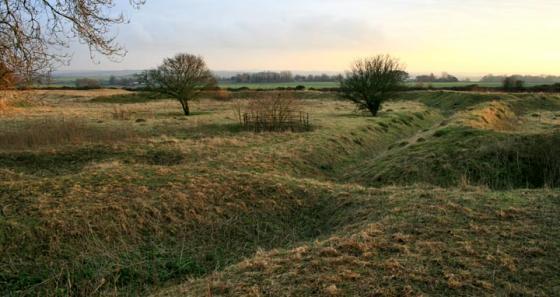Details of Barrow cemetery on Pastscape
A barrow cemetery on Launceston Down excavated in 1938 by S and CM Piggott under “rescue” conditions following government acquisition of the land. None of the barrows now survive as earthworks. Of the 10 examined by the Piggotts, one apears to be Neolithic, one Saxon and the remainder Bronze Age in date. All were formerly listed and described as part of this monument record, but have now been recorded separately. See individual child monument records for specific details about each.
(ST 95501069:ST 95621064:ST 95881056) Tumuli (NR) (sites of) (NAT) (twice). (1)
Round barrows between 200 ft. and 250 ft. above O.D., extend in an irregular line from W.to E. on the northwood-facing slope of a dry combe which falls E. to the Crichel brook. All were excavated in 1938 by S. and C.M Piggott; they are no longer visible on the ground and former dimensions, etc. are recorded.
(A) Bowl (95381067), covering a primary cremation, associated with a calcite double-spaced bead, in a circular grave cut into
the chalk; diam. 25 ft., ht. l ft. (Piggott, 18).
(B) Bowl (95501069), disturbed in the past, yielded a cremation, probably primary, under an inverted cinerary urn in a shallow pit in the chalk; diam. 35 ft., ht. 1 1/2 ft. (Piggott, 12).
(C) Bowl (95621064), with a primary crouched inhumation near the centre associated with a leaf-shaped arrowhead; diam.
40 ft., ht. l1 ft. (Piggott, 13).
(D) Bowl (95731061), covering a primary cremation in a pit cut into the chalk; diam. 12 ft., ht. 1 ft. (Piggott, 15).
(E) Bowl (95741058), containing a primary crouched inhumation with a trephined skull, associated with a bell beaker, in a
central grave cut into the chalk, and a secondary cremation near it; diam. 17 ft., ht. less than 1 ft. (Piggott, 14).
(F) Bowl (95771060), apparently disturbed by earlier digging, probably had contained a primary inhumation associated with a
small long-necked beaker; diam. 25 ft., ht. 1 ft. (Piggott, 16),
(G) Bowl (95711050), containing a primary crouched inhumation, associated with a bronze awl and a long-necked beaker, in a
large grave cut into the chalk. An urn of ‘degenerate food-vessel’ type was found in a secondary position in this grave. Diam. 18 ft., ht. 1 ft. (Piggott, 17).
(H) Bowl (95891056), yielding a primary cremation and four secondary cremations, one of them associated with an inverted
sub-biconical urn. An intrusive crouched inhumation near the edge of the mound was probably Romano-British or pagan Saxon
Diam. 40 ft., ht. 2 ft., with a horseshoe-shaped ditch with a causeway on the E.
(J) Bowl (95901060), with three extended inhumations, perhaps intrusive and probably of pagan Saxon origin, in a shallow
scraping in the chalk; diam. 20 ft.. ht. less than 1 ft.
(K) Bowl (95911054), covering a large pit, beside which was a primary cremation in a barrel urn with incised chevron
decoration of Cornish type; diam. 45 ft., ht. 1 ft., with a shallow ditch. (Piggott, 8). (2-3)
Piggott’s location map (op cit) shows barrow (E) lying slightly N of barrows (D) and (F). It is probably therefore situated at ST 95741062. (4)
(C) Launceston. ST 956 107 (sic) Listed by Kinnes as a Neolithic round barrow with 1 adult inhumation, with a leaf arrowhead between the ribs, lying on a layer of flint nodules with 2 postholes at the feet. (5)






















































































